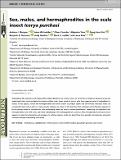Files in this item
Sex, males, and hermaphrodites in the scale insect Icerya purchasi
Item metadata
| dc.contributor.author | Mongue, Andrew | |
| dc.contributor.author | Michaelides, Sozos | |
| dc.contributor.author | Coombe, Oliver | |
| dc.contributor.author | Tena, Alejandro | |
| dc.contributor.author | Kim, Dong-Soon | |
| dc.contributor.author | Normark, Benjamin | |
| dc.contributor.author | Gardner, Andy | |
| dc.contributor.author | Hoddle, Mark | |
| dc.contributor.author | Ross, Laura | |
| dc.date.accessioned | 2021-05-10T09:30:10Z | |
| dc.date.available | 2021-05-10T09:30:10Z | |
| dc.date.issued | 2021-05-02 | |
| dc.identifier | 273541427 | |
| dc.identifier | 1e783c7b-9975-4d3b-9ec3-784ee63d85c3 | |
| dc.identifier | 85105232785 | |
| dc.identifier | 000645986900001 | |
| dc.identifier.citation | Mongue , A , Michaelides , S , Coombe , O , Tena , A , Kim , D-S , Normark , B , Gardner , A , Hoddle , M & Ross , L 2021 , ' Sex, males, and hermaphrodites in the scale insect Icerya purchasi ' , Evolution , vol. Early View . https://doi.org/10.1111/evo.14233 | en |
| dc.identifier.issn | 0014-3820 | |
| dc.identifier.uri | https://hdl.handle.net/10023/23136 | |
| dc.description | Funding: This work was supported by a number of fellowships, namely a University Research Fellowship from Royal Society of London (to AG) and a Junior Research Fellowship from Balliol College, Oxford to AG. Funding came from Independent Research Fellowships from Natural Environment Research Council (grant no. NE/K009524/1 to AG and NE/K009516/1 to LR), a Consolidator Grant from European Research Council (grant no. 771387 to AG), a European Research Countil Starting Grant (PGErepro to LR), and a Royal Society Newton fellowship (to LR). | en |
| dc.description.abstract | Androdioecy (the coexistence of males and hermaphrodites) is a rare mating system for which the evolutionary dynamics are poorly understood. Here we study the only presumed case of androdioecy in insects, found in the cottony cushion scale, Icerya purchasi . In this species, female-like hermaphrodites have been shown to produce sperm and self-fertilize. However, rare males are sometimes observed too. In a large population-genetic analysis, we show for the first time that although self-fertilization appears to be the primary mode of reproduction, rare outbreeding events between males and hermaphrodites do occur, and we thereby confirm androdioecy as the mating system of I. purchasi . Thus, this insect appears to have the colonization advantages of a selfing organism while also benefitting from periodic reintroduction of genetic variation through outbreeding with males. | |
| dc.format.extent | 12 | |
| dc.format.extent | 1747502 | |
| dc.language.iso | eng | |
| dc.relation.ispartof | Evolution | en |
| dc.subject | Androdioecy | en |
| dc.subject | Haplodiploidy | en |
| dc.subject | Mating systems | en |
| dc.subject | Microsatellite markers | en |
| dc.subject | Population genetics | en |
| dc.subject | Scale insects | en |
| dc.subject | QH301 Biology | en |
| dc.subject | QH426 Genetics | en |
| dc.subject | DAS | en |
| dc.subject.lcc | QH301 | en |
| dc.subject.lcc | QH426 | en |
| dc.title | Sex, males, and hermaphrodites in the scale insect Icerya purchasi | en |
| dc.type | Journal article | en |
| dc.contributor.sponsor | NERC | en |
| dc.contributor.sponsor | European Research Council | en |
| dc.contributor.sponsor | The Royal Society | en |
| dc.contributor.institution | University of St Andrews. School of Biology | en |
| dc.contributor.institution | University of St Andrews. Centre for Biological Diversity | en |
| dc.contributor.institution | University of St Andrews. St Andrews Bioinformatics Unit | en |
| dc.identifier.doi | 10.1111/evo.14233 | |
| dc.description.status | Peer reviewed | en |
| dc.identifier.url | https://www.biorxiv.org/content/10.1101/2020.09.04.281618v1 | en |
| dc.identifier.grantnumber | NE/K009524/1 | en |
| dc.identifier.grantnumber | 771387 | en |
| dc.identifier.grantnumber | UF100023 | en |
This item appears in the following Collection(s)
Items in the St Andrews Research Repository are protected by copyright, with all rights reserved, unless otherwise indicated.

